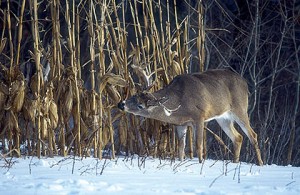
For late-season hunting during extremely cold weather, the author believes you should first locate a big buck to hunt by identifying the animal’s food source. Then you should set up your stand with a minimal amount of disturbance to the woods and use a low-impact routea both to and from that stand. The colder it is outside, the better!
You’re probably thinking that, despite the combination of brutal conditions and the fact that the deer were already ultra-skittish from a season’s worth of dodging both lead and arrows, I conquered every obstacle with bravado and the legendary king of all bucks. Wrong!
The truth is that I didn’t even see a deer during the eight straight days I crawled up into my various stands. To this day, I still wonder if every deer in the tri-county area where I was hunting had gotten a group rate on a vacation trip to Mexico. Sure, I sucked it up and went out each afternoon, but I’d be lying if I said I enjoyed the hunt. It was flat-out miserable. During the periods when I wasn’t wearing my Heater Body Suit, it might even have bordered on being life threatening.
Like it or not, that’s exactly what late season in the Upper Midwest and North can be like. It can test the will of the most avid hunter. I can’t speak for anyone else, but I’ve never bought the romantic notion that some hunters have embraced: that facing the worst Mother Nature can throw at a hunter and trying to endure it is a noble endeavor. Mother Nature can be nasty. To my way of thinking, she often saves the very worst for deer hunters. The thought of being able to endure it has never meant anything to me.
On the flip side, being able to kill a mature buck means everything to me! That, my friends, is the one and only reason to go late-season hunting. And luckily, even though Mother Nature can be miserable and even though deer have many biological and behavioral traits working against the hunter during this phase, late season can be and often is a great time to kill a mature buck. So let’s get down to the nitty-gritty and talk about some of the best ways to achieve this goal.
FIND THE BUCK
The first step in taking a late-season buck is to find one or more that you want to shoot. Although this step is vitally important, some hunters often seem to overlook it. In my 32 years of deer hunting, I’ve never tagged a mature buck during late season without having first seen him at some earlier point and then later purposefully setting up to kill him. And during most of those seasons, I’ve invested a good bit of time in late-season hunting, often on some pretty choice land.
Once you start factoring in what is going on in a buck’s life at this time of year, what they’ve endured and the state of the habitat, it starts making perfect sense. Hunting late season isn’t like hunting in October or November, when the bucks are much more active and they’re establishing their place in the buck hierarchy or trying to find and breed does. As a matter of fact, by late season, those endeavors have left most mature bucks in very poor condition. They’re worn down physically, they’ve lost 25 to 30 percent of their pre-rut body weight, and they might even be suffering from injuries received while fighting. And now, after all that, they must try to survive the winter.
To make matters worse, most mature bucks are now running a negative energy balance. This means that they burn more calories each day than they take in. With the worst still yet to come in the way of deeper snows, dwindling food supplies, and frigid temperatures, it’s easy to see why Mr. Big is walking a fine line between life and death.
Luckily, big bucks have several traits that help them combat all of these hardships. To begin with, their metabolism actually slows down and they save energy by minimizing movements. Daily movements often are reduced to little more than back and forth between bedding areas and food sources. Furthermore, bucks often shift much more of their daily movements to the warmer portions of the day, especially during extremely cold weather. Since night and early morning hours are most often the coldest, for Mr. Big that typically means moving and feeding more in the afternoon hours.
Obviously, the limited movement helps explain why stumbling blindly into a big late-season buck is a rarity. Also, since most food sources are at a seasonal low point, most deer concentrate around the few remaining prime sources. Heck, in areas where winter yarding occurs, many deer have also shifted to their traditional wintering areas. Add both of those together, and the result is a high concentration of deer that move very little. To the hunter, that means find the buck or sit watching leafless trees making cracking sounds in the wind.
Simply put, the most likely place to find Mr. Big is the area’s best food source. Because older bucks have such a low tolerance for disturbances, mostly because of us having tried to kill them all season long, this isn’t the best time to use scouting cameras. The trip in to set them up and the return trip to check the cards are simply too risky.
Instead, long-range observations are the route to go. In a nutshell, stay as far away as your optics and field of view will allow. Toss in keeping the wind in your face and selecting a safe route in and out, and you’re three-quarters of the way there. The final quarter is doing nothing more than mentally marking the trail Mr. Big uses to enter the food source. Do that, and you’re one step closer to possibly scoring a great late-season buck.
MINIMIZE DISTURBANCES
The next step is to minimize disturbances. That begins with taking odor control to the extreme and realizing that you still must play the wind. Up until December 1, I honestly don’t allow the wind direction to stop me from hunting a stand that I really want to be in. Heck, I don’t shy away from the nastiest bowl, despite the promise that swirling winds often will carry my scent to every deer dropping down the sides or in the bottom. I truly believe that the products I use and my odor reduction techniques allow me to get away with murder during the early part of the season.
However, everything changes after December 1. With all of the vegetation in the woods dead or dormant and virtually odorless, and with the frozen habitat giving off far less natural odors than at any other time, I hunt the wind religiously from that point on because mature bucks are ultra-wary. Maintaining the odor control techniques I always use definitely provides a bit more of an edge. That edge can come in extremely handy, since Mr. Big is likely to vanish at the first hint of danger.
Keeping that in mind, I still recommend doing everything you can do within reason to cut odor. Once you’ve done this, strap a stand to your back and time a stand-hanging trip for late morning. Select a low-impact route to your chosen spot, get in, get the stand up and get the heck out. This is not the time for milling around, trimming shooting lanes or even bringing a friend in to help. Keeping disturbances to a minimum is Job 1, even at the expense of limited shooting options.
Setting up on the food source is probably your best option. That keeps you out of the woods. Paired with a wind that is quartering into the woods and away from the buck trail you are watching, that setup can be hunted safely and it will also allow shots at bucks that might feed to within bow range.
Unfortunately, some bucks refuse to enter the food source before dark. If you suspect that might be the case, follow the buck’s trail back into the woods for 100 yards or so. When setting up your stand, make sure you move off the trail as far as you can (maybe 20 or 30 yards) while still being able to see the trail and make the shot.
While this placement may eliminate an opportunity to see feeding deer, you may just see that big buck as he waits for total darkness to set in before he steps out into the open. Also, a big plus in using this setup is in being able to sneak out of the woods safely without spooking all of the deer in the food source. In either case, remember that playing the wind is key.
CONCLUSION
The final step is praying for cold. Like it or not, the colder and nastier it gets, the better your odds are of getting Mr. Big on his feet and feeding before darkness sets in. That is the advantage that late season provides. When Mother Nature is at her worst, even the most nocturnal buck’s survival tendencies desperately want to kick in. Under those conditions, bucks are more likely to move during daylight more so than at any other time outside of the rut.
Late-season hunting is fairly simply. Here is a recap of the four important points this article has discussed: 1) Find the buck. 2) Set up with minimal disturbance to the woods. 3) Take a low-impact route to your stand. 4) Pray for cold temperatures.
Freezing may not be romantic, but it can provide the edge needed to put a very special head on the wall!


